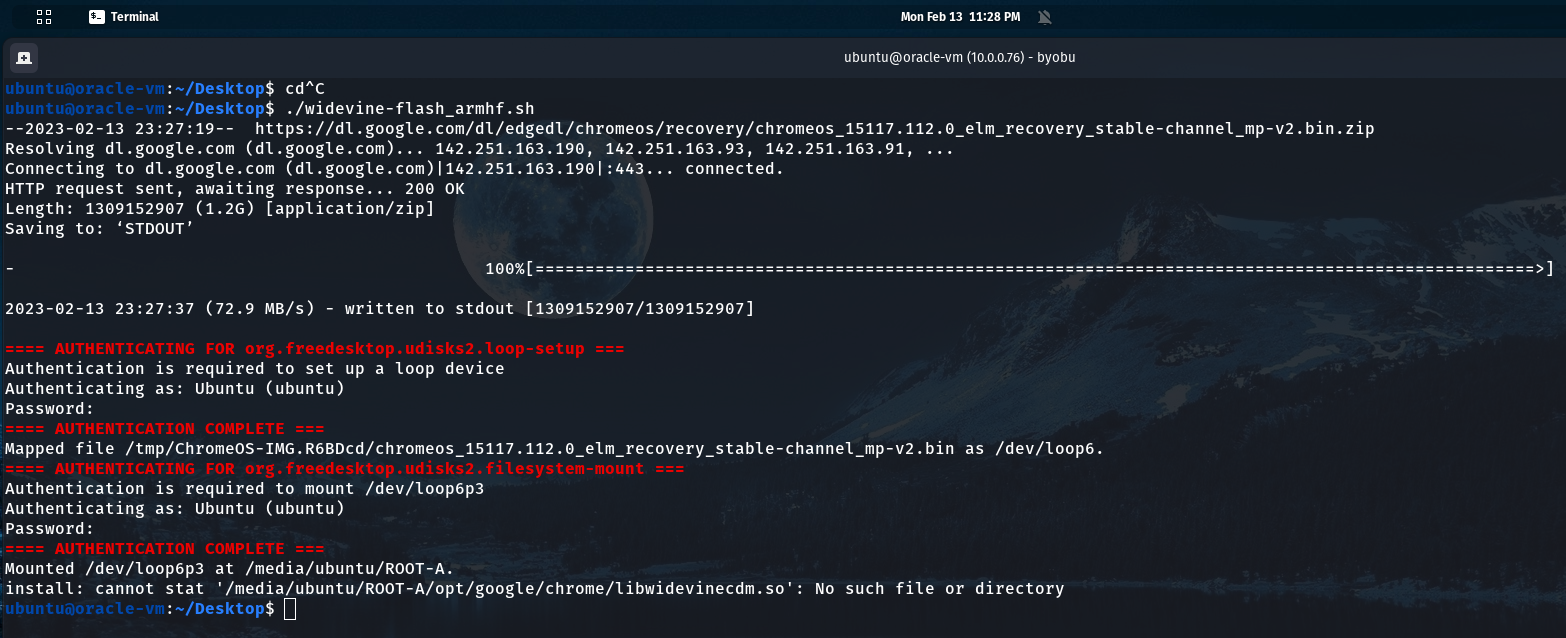|
#!/bin/sh -eu |
|
|
|
# Make sure we have wget or curl |
|
available () { |
|
command -v "$1" >/dev/null 2>&1 |
|
} |
|
if available wget; then |
|
DL="wget -O-" |
|
DL_SL="wget -qO-" |
|
elif available curl; then |
|
DL="curl -L" |
|
DL_SL="curl -s" |
|
else |
|
echo "Install Wget or cURL" >&2 |
|
exit 1 |
|
fi |
|
|
|
# Find a URL to a suitable armhf ChromeOS recovery image |
|
CHROMEOS_URL="$($DL_SL https://dl.google.com/dl/edgedl/chromeos/recovery/recovery.conf | grep -A11 CB5-312T | sed -n 's/^url=//p')" |
|
CHROMEOS_IMG="$(basename "$CHROMEOS_URL" .zip)" |
|
if [ -e "$CHROMEOS_IMG" ]; then |
|
CHROMEOS_IMG_PATH="./" |
|
DEL_IMG=N |
|
else |
|
CHROMEOS_IMG_PATH="$(mktemp -td ChromeOS-IMG.XXXXXX)" |
|
DEL_IMG=Y |
|
# Fetch the recovery image (2Gb+ on disk after download) |
|
$DL "$CHROMEOS_URL" | zcat > "$CHROMEOS_IMG_PATH/$CHROMEOS_IMG" |
|
fi |
|
|
|
# Note the next free loop device in a variable |
|
LOOPD="$(losetup -f)" |
|
|
|
# If root, we can mount silently (no popup windows after mount) |
|
if [ "$USER" = "root" ]; then |
|
MNTPNT="$(mktemp -d -t ChromeOS.XXXXXX)" |
|
losetup -Pf "$CHROMEOS_IMG_PATH/$CHROMEOS_IMG" |
|
mount -o ro "${LOOPD}p3" "$MNTPNT" |
|
else |
|
# Associate all the partitions on the disk image with loop devices: |
|
udisksctl loop-setup -rf "$CHROMEOS_IMG_PATH/$CHROMEOS_IMG" |
|
sleep 1 |
|
# Mount the third partition of the disk image (if the previous did not do it automatically) |
|
if ! lsblk -lo MOUNTPOINT "${LOOPD}p3" | tail -n1 | grep -q \.; then |
|
udisksctl mount -b "${LOOPD}p3" |
|
fi |
|
# Note the mount point in a variable |
|
MNTPNT="$(lsblk -lo MOUNTPOINT "${LOOPD}p3" | tail -n1)" |
|
fi |
|
|
|
# Copy over files and make manifest |
|
CHRFILES="$(mktemp -d -t ChromeOS_Files.XXXXXX)" |
|
install -Dm644 "$MNTPNT"/opt/google/chrome/libwidevinecdm.so "$CHRFILES"/opt/WidevineCdm/_platform_specific/linux_arm/libwidevinecdm.so |
|
WVVER="$(grep -Eaom1 '([0-9]+\.){3}[0-9]+' "$CHRFILES"/opt/WidevineCdm/_platform_specific/linux_arm/libwidevinecdm.so)" |
|
WVMGR="$(echo $WVVER | cut -d. -f1)" |
|
WVMIN="$(echo $WVVER | cut -d. -f2)" |
|
echo "{\"version\":\"$WVVER\",\"x-cdm-codecs\":\"vp8,vp9.0,avc1,av01\",\"x-cdm-host-versions\":\"$WVMIN\",\"x-cdm-interface-versions\":\"$WVMIN\",\"x-cdm-module-versions\":\"$WVMGR\"}" > "$CHRFILES"/opt/WidevineCdm/manifest.json |
|
|
|
# Extract the libs out and copy them to a compressed tar archive |
|
ARCHIVE_NAME="widevine-flash-$(date '+%Y%m%d')_armhf.tgz" |
|
echo "Extracting and compressing files" |
|
tar -C"$CHRFILES" -caf "$ARCHIVE_NAME" opt/WidevineCdm/manifest.json opt/WidevineCdm/_platform_specific/linux_arm/libwidevinecdm.so --format ustar --owner 0 --group 0 |
|
rm -r "$CHRFILES" |
|
echo "Created: $ARCHIVE_NAME" |
|
|
|
# Cleanup |
|
if [ "$USER" = "root" ]; then |
|
umount "$MNTPNT" |
|
losetup -d "$LOOPD" |
|
rmdir "$MNTPNT" |
|
else |
|
ALLMNTS="$(lsblk -lo NAME,MOUNTPOINT "$LOOPD" | sed -n '/\//s/^\(loop[0-9]\+p[0-9]\+\).*/\1/p')" |
|
echo "$ALLMNTS" | xargs -I{} -n1 udisksctl unmount -b /dev/{} |
|
if [ "$LOOPD" != "$(losetup -f)" ]; then |
|
udisksctl loop-delete -b "$LOOPD" |
|
fi |
|
fi |
|
if [ "$DEL_IMG" = "N" ] || [ "${1:-EMPTY}" = "-k" ]; then |
|
: |
|
else |
|
rm "$CHROMEOS_IMG_PATH/$CHROMEOS_IMG" |
|
rmdir -v "$CHROMEOS_IMG_PATH" |
|
fi |
|
|
|
# Inform the user how to proceed |
|
cat <<EOF |
|
|
|
To install the contents of these files on an ARMhf device, copy the tar archive over to the target machine and issue the following: |
|
|
|
sudo tar Cfx / $ARCHIVE_NAME |
|
|
|
After install of these libraries, issue the following two commands and restart Vivaldi: |
|
|
|
mkdir -p ~/.config/vivaldi/WidevineCdm |
|
echo '{"Path":"/opt/WidevineCdm"}' > ~/.config/vivaldi/WidevineCdm/latest-component-updated-widevine-cdm |
|
|
|
EOF |

I tested as well today with Vivaldi 3.4.2066.94 and Widevine 4.10.1679.0 on a Rpi 4. Lib is loaded and DRM passes the test but Netflix deny the access with this stupid error.
As mentioned above, it's cause by the User Agent. The User Agent Switcher extension in Chrome Store are not working properly (they must be very badly coded, this is just a HTTP header 🤦)
Switching the user agent from the CLI is simpler and working fine :